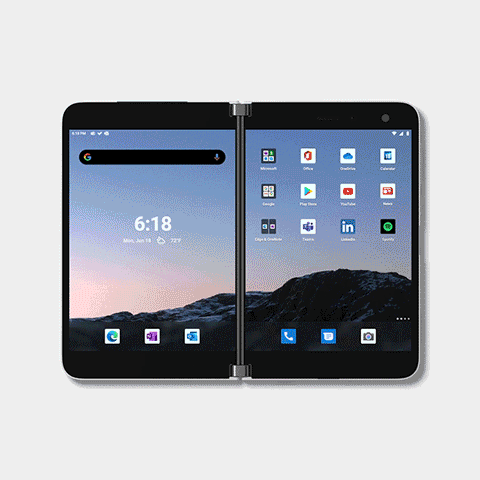Microsoft Reveals Plans for Surface Duo Dual-Screen Phone that Unfolds
One analyst predicts the channel will be important to sale of the phone over time.
August 12, 2020

Microsoft is officially back in the smartphone business with the debut of its new Android-based, foldable Surface Duo device.
The new dual-screen phone that unfolds into a mini tablet will ship Sept. 10, Microsoft revealed Wednesday. It will cost $1,399 for a 128GB of storage and $1,499 for 256GB. Previewed last fall as a prototype, Microsoft partnered with Google to integrate an Android Windows-style desktop onto the device.
While it is available with LTE communications on wireless networks from AT&T, T-Mobile and Verizon, the Surface Duo is not 5G-capable. Initially, customers can buy an unlocked version of the Surface Duo or one with an AT&T SIM card. AT&T is the first to sell the Surface Duo, either to consumers or its commercial channel partners.

Microsoft Surface Duo
Microsoft is positioning the Surface Duo as a new device “category.” In a blog announcing the Surface Duo, Microsoft’s chief product officer explained how the company is positioning the device.
The company doesn’t want to “reinvent the phone,” Panay noted. “But [we want] to inspire people to rethink how they want to use the device in their pocket.”
Folded, the device is 5.7-inches long by nearly 3.7-inches wide, which could fit tightly in large pockets. When open, the two displays can converge into one, or render separate applications.
“The ability to use two screens together on a mobile product has a real impact on how you create, how you share, and how you feel when using the product,” Panay noted.
While Microsoft describes the Surface Duo as a new category, the company isn’t the first to deliver such a device. The Motorola Razr last year reappeared last year as a dual-screen, foldable phone. Just last week, Samsung previewed the second version of its dual-screen phone. The Korea-based phone giant previewed its planned Galaxy Z Fold2 device during the launch of its Galaxy Note20 and Tab S7 lines. Notably, while the two companies are competing, they also extended their ongoing alliance last week, to enable better Windows and Office integration on Samsung tablets and phones.
Samsung’s first dual-screen phone, the Galaxy Flip, arrived last year. The Samsung Galaxy Flip is available with either standard LTE connectivity or a 5G model. Samsung hasn’t revealed when the Z Fold2 will arrive, other to indicate it will have more to say on Sept. 1. But the Samsung Galaxy Z Fold2, which address shortcomings of last year’s model, is also 5G-capable. It also supports Wi-Fi 6 wireless LANs. Microsoft’s new Surface Duo only supports standard LTE and Wi-Fi 5.
“The Surface Duo is trying to establish a new category of device,” said Techsponential analyst Avi Greengard. “Microsoft spent a lot of time working on the form factor and software. That meant Microsoft sacrificed certain features, including 5G, Wi-Fi 6, and the latest processors and cameras.”
Customers can immediately order the Surface Duo from the Microsoft Store, Best Buy or via AT&T. The Surface Duo announcement also noted that business customers can reach out to some of Microsoft’s larger resellers. Among those highlighted include CDW, Connection, Insight, PCM, SHI, SoftChoice, Staples, Verizon and Zones. None appear to be taking orders yet.
“Ordinarily, Microsoft’s commercial partners would be an ideal way to sell a productivity-oriented device into the enterprise, and over time I expect that this channel will be important,” Greengard said. “During the pandemic, however, I expect most sales will be at AT&T or, for Microsoft Surface fans, direct to consumer at the Microsoft Store and at Best Buy.”
It doesn’t appear likely that it will likely generate sales of Microsoft’s core Surface computing devices. Microsoft isn’t signaling that it expects otherwise.
“With Surface Duo, we want to help shape the dual-screen category by providing consistency in the way customers experience it and developers design apps,” Panay said.
Read more about:
VARs/SIsAbout the Author
You May Also Like


